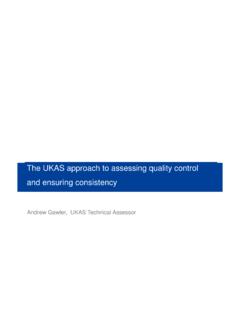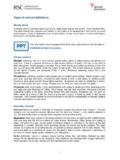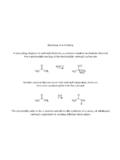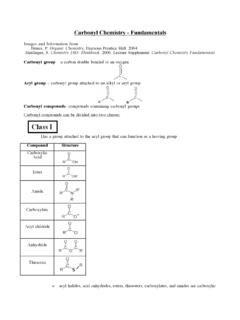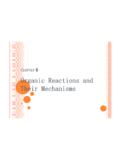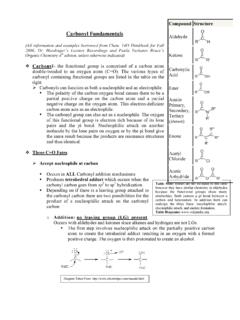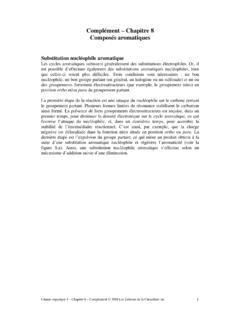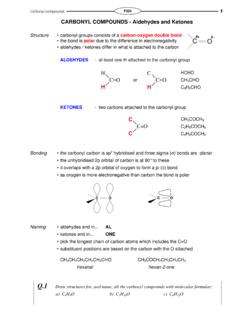Transcription of Organic pioneer - rsc.org
1 pioneer Christopher Ingold s insights into mechanism and reactivity established many of the principles of Organic chemistry. John Ridd reveals more about his life and workHistorical profile50 | Chemistry World | December 2008 ROYAL SOCIETY OF CHEMISTRY / LIBRARY AND INFORMATION Christopher Ingold fundamentally changed the approach of chemists to Organic chemistry. Many have forgotten what a strange and mysterious subject Organic chemistry appeared to be in the days before reaction mechanisms were revealed. Organic chemistry is now viewed in a very different way based on firmly established mechanistic principles and, although many people have contributed to that change, almost all chemists would now accept that Ingold was the predominant figure. Although this account focuses on his work in Organic chemistry, Ingold also made important contributions to spectroscopy and inorganic was born in London on 28 October 1893.
2 His father, a silk merchant, was in very poor health with tuberculosis; it was for this reason that the family moved to the supposedly gentler climate of Shanklin in the Isle of Wight. But his father died when Ingold was five years studying at the local school in Shanklin, Ingold moved to the new secondary school at Sandown where he obtained a county scholarship to study at the new Hartley University College in Southampton. After obtaining his BSc degree there, he moved to Imperial College London and, in 1914, joined the research group of Jocelyn Thorpe, a new professor of Organic chemistry. In 1915, he was asked to carry out work in Glasgow on the preparation of gases for use in chemical warfare. This was dangerous work for which Ingold was awarded the British Empire Medal. He subsequently made no reference to the award or to his work during the chemistryIn 1920 Ingold returned to Imperial College as a demonstrator with his own research laboratory.
3 It was the beginning of a remarkably active period of research: he published 12 papers in 1921, 16 papers in 1922, and 14 papers in 1923. Most of these dealt with classical Organic chemistry, and some with physical chemistry, including specific heats and vapour s impressive publication record led to rapid movement up the academic ladder he was promoted to a lectureship, gained a DSc (doctor of science) degree and was awarded the first Meldola Medal in 1922 an award to commemorate Raphael Meldola, who was president of both the Society of Maccabaeans and the Royal Institute of Chemistry. Remarkably, he was also awarded a second Meldola Medal in 1923, and was the only person ever to receive two medals (the rules were subsequently changed to make it impossible for an applicant to receive more than one). In 1924, he was elected to fellowship of the Royal Society and accepted the position of professor of chemistry at Leeds University, those years, there was another important, more personal development in Ingold s life.
4 In 1922 he published a paper with Edith Hilda Usherwood on the specific heats of gases and, a year later, they were married. His wife was herself a talented chemist but, after a few years, she gave up her research and supported her husband s scientific Leeds, Ingold s interests rapidly turned to the nature of chemical bonding. Robert Robinson, who was then a professor at the University of Manchester, UK, had recognised that the current discussions, in terms of partial valency and chemical affinity, lacked any common physical basis and suggested that this could be found in the electronic theories of valency put forward by Thomson, Lewis and Langmuir. In his 1922 paper, Robinson used Arthur Lapworth s description of reagents as kationoid and anionoid but added what we would in modern terms call inductive and conjugative electron shifts.
5 There are even two of the now common curly arrows to represent the movement of electrons in a conjugated system. In his paper on tautomerism in 1926, Ingold also interpreted the results in terms of electron movements, this time making extensive use of curly arrows. The paper contains one reference to Robinson s work published in the same year, but was the start of the long-standing controversy between In short Christopher Ingold established some of the fundamental mechanisms of Organic chemistry Possibly his most important work was on the mechanism of substitution reactions He described, for the first time, the two different forms of nucleophilic substitution, SN1 and SN2 His Organic chemistry textbook soon became an essential reference Ingold, Hughes and Ingold s wife Hilda at a UCL dinner marking Ingold s receipt of the Longstaff medal from the Chemical Society Chemistry World | December 2008 | 51 and Ingold Robinson considered that insufficient recognition had been given to his earlier conventionsIngold continued to develop the theory of electronic effects in Organic chemistry, making a clear distinction between polarisation and polarisability effects and introducing the concept of mesomerism equivalent to the concept of resonance between valence bond structures as the permanent consequence of tautomeric electron displacements in a molecule before a reaction.
6 Ingold s terminology differs from that of Robinson, and this is also true of his description of reagents Ingold used the terms electrophilic and nucleophilic in place of kationoid and anionoid on the basis that whether a reagent is electron-attracting or electron-repelling is not simply dependent on its charge. The two scientists also disagreed on the sign to be attached to substituent effects. Ingold designated the effects of electron-donating substituents as positive and those of electron-withdrawing substituents as negative. Shortly afterwards Robinson proposed the opposite sign convention. Ingold s ideas were set out in his article in Chemical Reviews in 1934 and Robinson set out his own alternative system in two lectures published together by the Institute of Chemistry in , in the early 1930s, chemists were faced with two versions of an electronic theory of Organic chemistry with many similar features but using a quite different terminology and sign convention.
7 To write up their results, they had to choose one or the other, and quite quickly Ingold s approach became the one generally accepted. One reason for the preference may have been that more people read Ingold s article in Chemical Reviews than read the reprints of Robinson s lectures at the Royal Institute of Chemistry. But perhaps the main reason is that much of Robinson s interest moved from electronic theories to what he considered to be other major challenges particularly biosynthesis while Ingold maintained a rapid rate of publication in the area of mechanism and substituent effects. Robinson s bitterness over the way in which his presentation of the electronic theory was supplanted by that of Ingold continued for the rest of his life. In his autobiography, Robinson maintained that the electronic theory was his most important contribution to August of 1930, Ingold moved from Leeds to a professorship at University College London and remained there until his death 40 years later.
8 In the same year, he was joined by Ted Hughes, a young postdoctoral worker who had just taken his PhD with H B Watson at Bangor. This was the start of a long collaboration which lasted until Hughes s death 33 years later. After arriving at University College, Ingold began kinetic and mechanistic studies. As with his studies of substituent effects, Ingold introduced a language for mechanistic studies which eventually became accepted. He first grouped Organic reactions according to the underlying electronic processes involved. Thus the reactions of hydroxide ions and amines with alkyl halides together with the reactions of amines with alkyl ammonium ions were termed nucleophilic substitution at a saturated carbon atom because, although the reactions appear very different in the reagents and charges, they all involve the attack of a nucleophile and the departure of a leaving group with the bonding made a further distinction by investigating the kinetics of these nucleophilic substitutions.
9 He found two basic forms: in one, the rate of the reaction depended on the concentration of both the nucleophile and the Organic molecule it was attacking. In the other, however, increasing the concentration of the nucleophile made no difference to the reaction rate, which only depended on the concentration of Organic substrate. As Ingold worked out, that was because in the first kinetic form whose reaction path was termed SN2 both incoming nucleophile and substrate molecule were involved in the slow, rate-determining step of the reaction. In the second form, SN1, the rate-determining step involved only the Organic substrate, which slowly lost its leaving group, creating a carbocation that was then quickly attacked by a nucleophile (see left). This mechanistic distinction has an important bearing on the Ingold described, for the first time, the two different forms of nucleophilic substitution SN1 and mechanistic distinction has an important bearing on the stereochemistry of the substitution.
10 In two series of papers, Ingold and Hughes established that the SN2 reaction, where a nucleophile attacks and a leaving group departs simultaneously, always inverts the 3D arrangement of atoms neighbouring the reaction centre rather like an umbrella turning inside out. The SN1 reaction, however, can either invert or retain the starting arrangement, since the planar carbocation can be attacked by the nucleophile on either side. The attack on the two sides may not occur to an equal extent because of partial screening by the leaving group. This relationship of the stereochemistry to the detailed mechanism provided an explanation of a long-standing problem in Organic chemistry called the Walden inversion where if a particular substitution reaction was attempted using different conditions, it could be made to either retain or invert + + XYAlk+fastYAlkYAlkXYAlk + X(SN1)(SN2)Ingold s mechanisms solved a stereochemical problemSubstitution mechanismsHistorical profileSir Robert Robinson (above)
